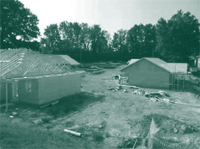December/January 2008
In this Issue
Three Decades of Housing Data
Mixed-Financing Underwrites Affordable Housing in Southwest Virginia
A Lean Makeover for Factory-Built Housing Production
Housing First for the Chronically Homeless Mentally Ill
In the next issue of ResearchWorks
Mixed-Financing Underwrites Affordable Housing in Southwest Virginia
A former public housing site in Bristol, Virginia is being redeveloped with accessible, affordable housing, thanks to a mixed-financing package assembled by the Bristol Redevelopment and Housing Authority (BRHA). Sapling Grove Apartments, a cluster of 13 one- and two-bedroom duplexes, will provide its residents with the added environmental and operational benefits of energy-efficient housing.
A combination of federal and private subsidies is funding the $4 million Sapling Grove project. Low-income housing tax credits provided more than $3 million of the construction cost, with the remainder coming from HUD’s Replacement Housing Factor Fund, the Capital Fund, and other unrestricted funds. With a mortgage loan from the Virginia Housing Development Authority (VHDA), BRHA’s debt on the property will be only $400,000. BRHA is even putting most of its developer’s fees back into the project. “We were the first housing authority in Virginia to get a mortgage for this kind of project from VHDA,” said Executive Director Dave Baldwin.

Of the 26 units, public housing subsidies will fund 10 and tax-credits will fund 16. Sapling Grove will have upper and lower income limits, with preference given to elderly and handicapped individuals. The first tenants are expected to arrive in March 2008, with completion and final occupancy planned for July 2008.
Using Universal Design and Energy Efficiency
All Sapling Grove units feature universal design concepts that make them accessible to all residents. To accommodate residents with walkers or wheelchairs, the apartments have wide doorways and no steps. Five fully accessible units will be set aside for handicapped residents, including one for hearing-impaired individuals that features a fire alarm with a strobe light and flashing lights for the doorbell and telephone, and another for visually impaired individuals. The remaining units can be readily converted to provide full accessibility, allowing residents to age in place. Bathroom walls contain the support structures needed to add grab bars, and sink cabinets in the kitchen and bathroom have removable fronts to provide full wheelchair access.
The excavation and groundwork for the project have followed EarthCraft Virginia principles for green building, which promote healthy, energy-efficient homes that minimize environmental impact. The apartments will feature ductwork that’s sealed rather than taped, with all supply lines located in conditioned space. A vapor barrier under the floor will reduce moisture build-up and discourage mold and mildew from forming. All units will be sealed to reduce air penetration.
BRHA has also incorporated a number of energy-efficient features in Sapling Grove’s design. The 13 single-story duplexes will have Energy Star®-rated refrigerators, dishwashers, washers, and dryers. All appliances will be electric, because natural gas is no longer an affordable choice for Bristol residents. Other features that will help reduce utility costs for residents and BRHA include the following:
-
Energy Star low-E glass windows, which reduce heat loss and gain;
-
Energy-conserving insulation (e.g., R38 in ceiling), with all joints and penetrations taped to reduce heat loss;
-
High-efficiency heat pumps; and
-
High-efficiency water heaters.
“The units are sustainable,” said Todd Musick, BRHA’s vice president for capital investment. “We’re using fiber cement siding, brick veneer, and sandstone — the same materials that would be found in any new housing construction. We’re approaching this in terms of long-term sustainability.”
What Made It Work?

Baldwin credited some of BRHA’s success to hiring an attorney with experience in mixed-financing deals. “The attorney really helped us understand what we needed to do,” said Baldwin. “He got us connected to the right people at HUD and helped us determine what forms we needed to complete and what we needed to do.” One challenge was combining the HUD requirements and the equity providers’ requirements. “HUD was pretty accommodating as we were trying to close on the project. HUD completed its review on the day we needed it so that the project could move forward,” Baldwin said.
Fast-tracking from the outset, BRHA completed the various preconstruction processes concurrently. “We began the disposition process on the public housing property well in advance,” Baldwin said. “Then we applied for the low-income housing tax credits while the disposition process was underway. And we talked with our partners in the process and let them know what we planned to do.” Musick advised other housing authorities contemplating this type of project to “use as many resources as you can and create partnerships to help you reach your goals.”
Baldwin noted that developing affordable housing is a new step for BRHA, which has 400 public housing units and 254 residents with Section 8 vouchers. “For the past few years, we’ve been primarily a public housing and Section 8 management company. This 3project has opened up a whole new arena for pursuing affordable housing.”
Looking to the Future
BRHA is seeking a consultant to help redevelop its public housing stock and uncover new opportunities to develop affordable housing and redevelop neighborhoods. “We’re looking at how we can make our public housing units competitive in the local market,” said Baldwin. “We can’t rely on the Capital Fund, which doesn’t provide sufficient funds each year, so we may need to do more mixed-finance projects. We’re also thinking of expanding our housing services to meet other needs in the community — in particular, increasing homeownership opportunities and assisting in neighborhood revitalization in the area around the public housing complexes.”
For more information about BRHA, visit www.brha.com or contact Dave Baldwin, executive director, at 276.821.6255 and Todd Musick, vice president for capital investment, at 276.821.6264. To learn more about EarthCraft Virginia, visit their website at www.earthcrafthouseva-sf.org/.

